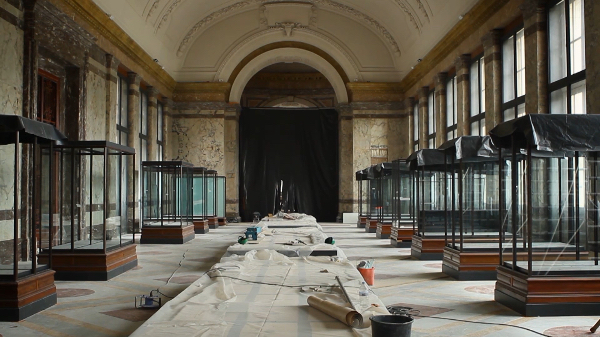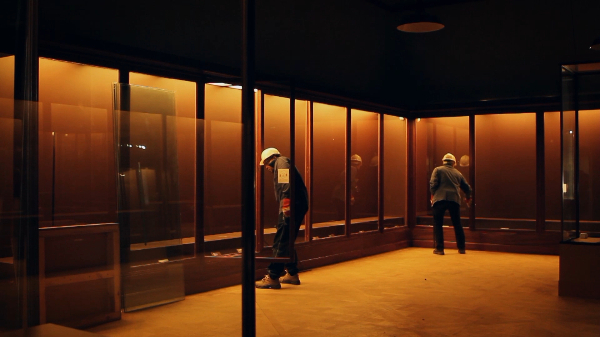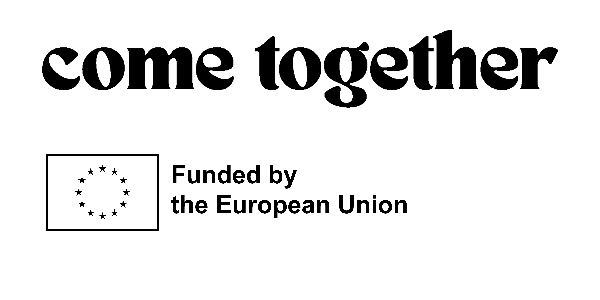The Rocks Have Left
Door Alana Osbourne, op Tue Jun 03 2025 12:14:00 GMT+0000After a series of strange incidents at the AfricaMuseum, now suddenly the minerals have disappeared. Is it theft, or is there more going on? The security cameras show nothing. But there were signs: reports of howling stones near the Congo River, leaking samples in natural history museums across Europe, and then that dull hum that seems to be coming from the copper sculptures in the Rotunda ...
Emiel was in the Africa Museum’s Rotunda, halfway through a tour he was giving to an assorted group of pensioners, when he felt the vibration. It was a faint sensation, a low buzz that caught his ears and made his body hum. It reminded him of the sound a distant lawnmower might make, but rather than coming from the grassy expanse of the surrounding park, it seemed to emanate from the statues, from the brass and copper effigies encrusted in the Rotunda’s alcoves. It gave Emiel the distinct impression that the sculptures were pulsating.
The day-trippers he was guiding that morning also picked up on the low rumble and began commenting on it. Noticing that they looked excited rather than concerned or inquisitive, Emiel deduced that these tourists were part of the recent influx of museum-goers who had traveled to Tervuren hoping to witness one of the many strange occurrences that had recently been reported. The latest of these was the abrupt and inexplicable disappearance of the minerals from the geological room. Recalling the morning he had arrived at the museum to find swarms of police officers and the building entirely closed off to visitors made him feel wobbly, a sensation heightened by fatigue. The shock of it all, followed by the lengthy and chaotic police investigation, had been exhausting for museum employees. In the days that followed, all events had been canceled, tours postponed, and extensive search parties had been led through the labyrinthine underground archives.
Rocks sprouting legs and marching out of a museum at night? Melting into runaway puddles? Or simply – poof – disappearing in a cloud of smoke?
There had also been the endless drafting of press releases. The running title of the latest statement read ‘The Rocks Have Left’ and was accompanied by a picture of the museum’s mineral room, with its beautifully adorned ceilings, hollowed-out curiosity cabinets, and bare glass displays. The article’s heading had been the subject of heated debates among museum staff. The conversation centered on semantics: could minerals leave? Did this choice of words truly capture what had taken place? Minerals ‘having left’ suggested a form of inorganic action that half of the staff wanted the article to convey. In their view, this sense of agency wasn’t just a journalistic flourish; it best described the vanishing of geological specimens from the museum’s permanent display, as well as another 17,000 chunks of rock from the serpentine corridors of the research institute adjacent to the museum.
The others, still disbelieving the chain of events that had led them to publish such an article, wanted to emphasize the possibility of human action in the matter. They refused to accept the idea that minerals could leave; that is, move by themselves. Rocks sprouting legs and marching out of a museum at night? Melting into runaway puddles? Or simply – poof – disappearing in a cloud of smoke? All options seemed incongruous. Any scenario was obscene. The stuff of comic books at best. Yet the mineral cabinet was resolutely empty, and security footage from that June night revealed nothing. A frame-by-frame analysis of surveillance recordings showed that one second the rocks were there, and the next, they were gone.

In hindsight, Emiel thought there had been signs. Reports of oddly behaving rocks had peppered the news in the months leading up to the big vanishing. The Smithsonian had stated that specimens from the Congo River Basin had been emitting a distinct cry, a mournful sound that filled the GeoGallery at night. Scientists from all over the world had poured in to listen to the stones weep. A famous electronic music producer had even recorded them and laid the sound over a heavy drum and bass track. The final product was still trending on Spotify. Natural history museums across Europe recounted that samples were inexplicably leaking a dark substance, a watery trail of iron and manganese oxides. There had been increasing reports of diamonds turning a murky brown, and disgruntled brides across Europe were asking jewelers for proofs of origin and refunds for their gems. But vanishing rocks? That was a first.
Natural history museums across Europe recounted that samples were inexplicably leaking a dark substance, a watery trail of iron and manganese oxides.
Of course, crying and sighing rocks had prepared people for inexplicable happenings. Yet it was much harder to rationalize or explain the evaporation of an entire rock collection without a narrative that relied on some form of human intervention. It seemed impossible that no one could be held accountable so, without signs of a break-in or any evidence pointing to a security breach, the investigation had turned inward, narrowing in on the museum staff. Months in, the police inquiry was still ongoing, and everyone was watching everyone. An ambient paranoia reigned so thick Emiel often found himself being suspicious of his co-workers, questioning the whereabouts of others, constantly hypothesizing motives and potential theft proceedings.
The tour guides, who were considered semi-outsiders due to the nature of their freelance contracts, were under particularly intense scrutiny. Their homes had been searched, their steps retraced, and their movements in and out of the museum were continuously dissected. It didn’t help that some, Emiel among them, had voiced strong critiques of the museum’s curatorial practices over the course of their employment. Their demands for a revision of the museum’s narrative and their advocacy for the inclusion of Afro-descendant voices in the higher rungs of the institution were now interpreted as evidence of guilt. Just last Wednesday in the breakroom Sophie, a guide who offered decolonial tours, had suggested that the rocks must have restituted themselves. ‘They were probably jealous of the artifacts we shipped back to the DRC’, she joked. Emiel had chuckled. For a brief moment, Sophie’s sharp humour had managed to lighten the collective mood. She was let go the next day.
Since then, during every tour he led, Emiel felt a court of museum directors and police officials breathing down his neck. Yet, in the privacy of his mind, he clung to the incongruous possibility that the minerals had returned to Congolese soil, reinserting themselves into long-lost subsoils – a small, temporal loop in the grand narrative of geologic time. There was a poetic justice in this, he thought, especially now that Congolese lands had been declared barren, with mining attention diverted outward, towards floating asteroids.
Around the same time as the theft – or disappearance (he still struggled to settle on either possibility) – the first AstroForge robots had drilled an asteroid, breaking through its crust to extract metals and ores similar to those found deep within the Earth's folds. The process had been live-streamed across the globe and was internationally celebrated as ‘Mankind’s second giant leap’. The proximity of this event to the strange series of incidents in geological collections worldwide struck Emiel as more than coincidental. Reading these events in conjunction revealed something, though he wasn’t sure what, or how. Earth, asteroids, moons, crying rocks, and vanishing minerals … it was all made of the same elements, blasted apart 4,6 billion years ago when our solar system came into being. Bringing it all together in his mind was dizzying, yet it was connected, at least through imperial compulsions to extract. But mining robots made poor culprits for museum theft.

This pattern of copper veins extended beyond the museum, running through 19th-century edifices to provide light, structure, and shine in the grand buildings and private homes of Brussels, Ghent, Antwerp, Charleroi, and Liège.
As he played these events in his mind, stringing celestial rocks together like clues on the evidence board of a terrible crime scene, Emiel’s thoughts were interrupted by the delicate touch of a hand on his forearm. It was an elderly woman, one of his candy-floss-haired day-trippers, eager to hear his take on the Rotunda noise. Clearing his throat to get the group’s attention, Emiel offered a vague but plausible lie about renovations taking place in a contiguous room. The group’s concerned chatter died down, and they slowly gathered around him expectantly, waiting for him to resume his telling of the museum’s history, contestations, and alterations.
Now that Emiel had quelled the visitors’ queries about the droning statues, he pushed through his well-rehearsed account of the relations between the succession of artworks that adorned the Rotunda. But detailing the materials used for the colonial statues nestled in the Rotunda, it struck him that the ores from which these sculptures were formed must have been extracted from rocks much like those that had disappeared from the Mineral Cabinet. Statues, domes, spires, wall cladding, wires … all derived from mining. The museum’s skeleton suddenly appeared to him as a frail copper structure, upholding a behemoth of colonial architecture, a gigantic palace of plunder. This pattern of copper veins extended beyond the museum, running through 19th-century edifices to provide light, structure, and shine in the grand buildings and private homes of Brussels, Ghent, Antwerp, Charleroi, and Liège. In the grid-like map his mind drew, the country was shot through with inorganic matter, and Tervuren stood as its central nervous system. Now that the rocks had vanished, would the copper melt away? If it did, how would the building stand? Would it come undone, rock by rock, forcing memory to be retold anew?
You can read the Dutch translation here.

This article was published in the context of Come Together, a project funded by the European Union.